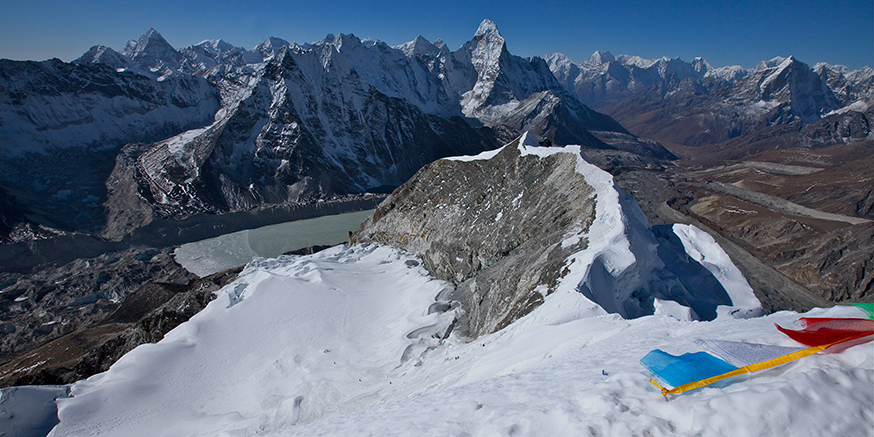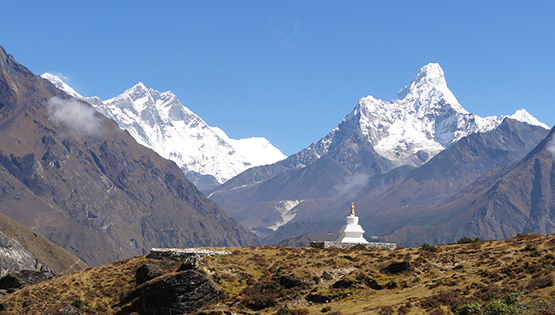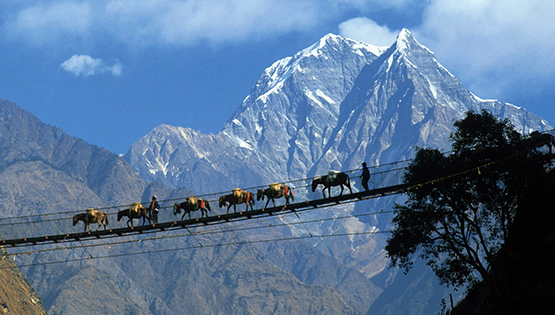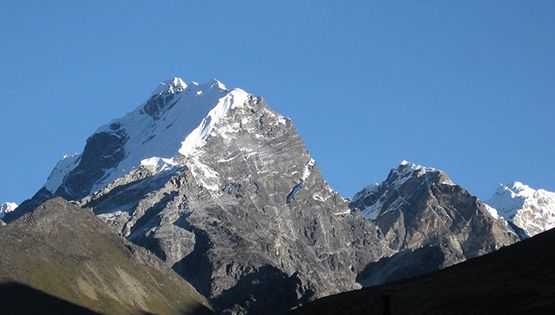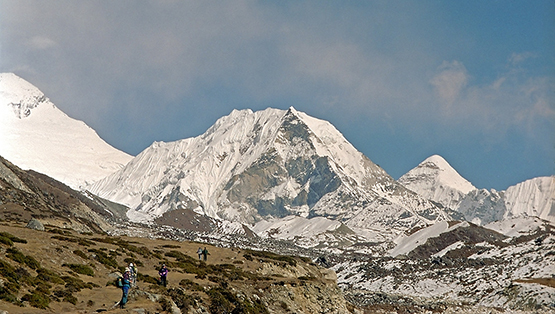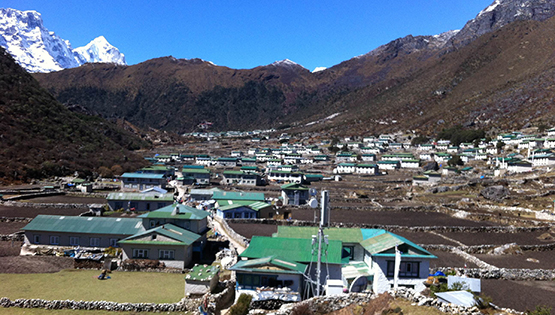Ama Dablam is a mountain in the Himalayan range of eastern Nepal. The main peak is 6,812 metres (22,349 ft), the lower western peak is 5,563 metres (18,251 ft). Ama Dablam means "Mother's necklace"; the long ridges on each side like the arms of a mother (ama) protecting her child, and the hanging glacier thought of as the dablam, the traditional double-pendant containing pictures of the gods, worn by Sherpa women. It is one of the most stunning peaks in the Himalaya and one of the most impressive mountains in the world. Situated in the heart of Everest's Khumbu region, it lies directly above Tengboche Monastery on the well-worn path to Everest Base Camp and is admired by thousands of trekkers and climbers every year. This expedition offers a superb, technical climbing experience in a magnificent setting, with numerous cultural and scenic diversions. The expedition is not a "guided" ascent. It will be a professionally led team of competent mountaineers who have enough experience to climb one of the world's most sought after mountains without undue risk. This approach ensures that team members are suitably experienced, reasonably self-sufficient and capable and willing to move between camps unsupervised. You will still have a high level of support, starting with strong, confident leadership; this will maximize your chances of success without undermining the quality of your achievement.
Like the Matterhorn in the Swiss Alps, Ama Dablam epitomizes all that is grand about the mountains. Its striking features have become a familiar figure to the public through its adoption as the logo of 'Perpetual', an international assurance company, and numerous posters and books throughout the world. Such impressive beauty has made Ama Dablam a highly coveted prize for climbers. Since its first ascent in 1961 by an Anglo-American-New Zealand team, it has been climbed frequently and by many different routes. As you might expect for such a mountain, some of these routes are of the highest order of difficulty. Our route will be by the original line of ascent, the South West Ridge. This gives a fine and varied climb, sustained at a reasonable level of difficulty and with good camp platforms at strategic points. The climbing provides interest on rock, snow and ice and although of a fairly technical nature, in normal conditions it is never very difficult. Apart from one short section, the climb is objectively very safe. A route description is included in the detailed itinerary. Island Peak named in 1952 due to its striking resemblance to a sea of ice, later it was renamed Imja-Tse in the early 80s. Its original name is more often used, however. First climbed by a team preparing for an Everest ascent in 1953, Island peak has an impressive, highly glaciated West Face which rises from the Lhotse glacier. In fact, the mountain extends from the south ridge of Lhotse Shar and is separated only by a small col. above this gap is the ridge leading to summit. From base camp, we will ascend a steep, grassy slope and small rocky steps to high camp. It is necessary to climb a steep, exposed 300m snow and ice ramp to the summit ridge, fixed ropes will be used at this point in an otherwise non-technical snow climb. We will negotiate a final tricky snow pitch before reaching the summit. Again stunning views of the surrounding mountains can be seen from the peak, including Nuptse, Cho-polu, Makalu, Ama-Dablam and Barunste. We promise to provide the finest service in the industry, which starts on the arrival in Kathmandu & end on the day of your international departure which strongly includes the successful climb of Mt. Ama-Dablam by the support of our strong, technical, communicative, Co-operative Sherpa staff all the time & our excellent base camp service to the personal attention you will receive on your trip so always try to provide you the best services without any comment. 'So if you have the necessary experience and wish to participate fully as a team member of an expertly led expedition to one of the world's most impressive mountains, this could be the trip for you. '

A very warm welcome to the Kingdom of Himalayas. Upon your arrival at the Tribhuvan international airport our representative welcomes you and assists you transfer in your hotel in Kathmandu. After time to get refreshed, evening you'll meet and transfer for welcome dinner in one of the typical Nepalese restaurant in the heart of Kathmandu i.e. Utsav or Nepali Chula (Kitchen). Here you will not simply experience the traditional Nepalese dish but will be entertained with Nepalese traditional dance and folk songs. After the dinner, you will be transferred back to your respective hotel.

Kathmandu is the historical and cultural heart of Nepal and has been a popular destination for tourists ever since Nepal opened its doors to visitors. The city presents a wonderful mix of Hinduism, Tibetan Buddhism and Western influence in the Valley. Bauddhanath: Stupa with its 130 ft. dome. One of the world's largest Stupa, Bouddha is generally acknowledged to be the most important Tibetan Buddhist monument outside Tibet. Pupshupatinath Temple: Pashupatinath is considered one of the holiest shrines of all the Hindu temples. The temple has remained the presiding deity of ruling Nepalese Royalty. -After the city tour, our leader or guide will do the final briefing of the expedition. They will also take the opportunity to check the members' personal equipment as the city bazaars and climbing shops will provide the last chance to correct any deficiencies. Overnight at Hotel.

It's a panoramic thrill flying into Lukla in a Twin Otter plane on a clear day. The views of snow-capped mountain peaks sprawling around you outside your plane are almost ecstatic, beginning a whole chain of memorable experiences that stay with you for a long, long time. This is an exciting flight, which should give a glimpse of Everest in the distance. In Lukla, we will meet our trek staffs and porters and set off straightaway for our first night's stop at Phakding 2600m. Situated on the banks of the Dudh Kosi, which drains the whole of the Khumbu Region, this small hamlet is on the main trade route through the area and there are a number of clean, well-built lodges where we can spend the night.

We will continue up the banks of the Dudh Kosi, crossing it twice by small suspension bridges before reaching the village of Monjo where we will enter the Khumbu National Park. We will then cross the confluence of the Dudh Kosi and the Bhote Kosi on a high suspension bridge and climb steeply for about two hours up 'Namche Hill' to reach Namche Bazaar. This is a prosperous trading town and the capital of the Khumbu Region. Many Tibetans cross the nearby border to trade their wares and the local market is a fascinating spectacle. This is a good place to buy genuine Tibetan artefacts. Just across the valley to the east stand the peaks of Thamserku and Kangtega, both very impressive mountains.

Namche Bazzar is the highlight of EBC trek and the heart of the Everest (Khumbu) region which has government offices, ATMs, Internet cafes, shops, restaurants, a bakery and a colourful market each Friday evening and Saturday. This is first scheduled 'acclimatization' day for this trek. Health experts always recommend us to stay active and moving during the rest day too instead of being idle. If we trek few hundred meters vertical during the day, it will help us to acclimatize with the alien heights that we are going to confront on the trek. Having been born, guiding and leading trips in the Himalayas, we believe in the natural process of acclimatization, "Climb high, sleep low". We take an interesting side trip up to Khumjung and climb up to famous airstrip at Syangboche. Just above the airstrip is the Everest View Hotel (3800m), a Japanese scheme to build a deluxe hotel with great views of the highest mountains on Earth. The Khumjung valley surrounded by the snowy peaks of Kongde and Thamserku, and the sacred peak the Khumbiyul-lha hosts a well known monastery that houses a yeti scalp. Visit Hillary School which is at the same site and spending some time in Khumjung after having lunch there, we walk back down to Namche Bazaar. Overnight in Namche Bazaar.

From Namche, the well-worn Everest trail contours around the side of the valley high above the Dudh Kosi. As we follow the path, we will get our first really good views of the great peaks of the Khumbu: Everest, Lhotse, Nuptse and Ama Dablam. Passing by several villages and numerous tea shops, we will cross the Dudh Kosi River and make a steep climb to Tyangboche, home of an impressive and recently rebuilt monastery. We have plenty of time to look around Tyangboche (and have a cake at the bakery!), but at the height of the season it is a busy place, so we will drop down to the river and the village of Deboche a little further along the trail, where we will stay in a relaxing lodge.

Shaded by rhododendron trees, the trail crosses an airy suspension bridge just beyond Deboche. An hour's walking from here will bring us to Pangboche, an excellent viewpoint for Ama Dablam ('Mother's Charm Box') and home for the Sherpas who work on this imposing mountain each post-monsoon season. Contouring up the valley side, we will re-cross the river and turn up the Imja Valley to reach the picturesque farming village of Dingboche.

It is very important to spend an additional night here to aid to the acclimatization process. Dingboche is a good location for acclimatization, prior to our ascent up the upper section of the Khumbu Valley. It can be along a short hike of 400 meters climb to the Nangkartshang Gompa (Monastary) on the ridge, to the north of Dingboche village. From here we can catch a good view of Mt. Makalu (8463m) and the great views up the Khumbu and Imja Valleys. On the way back from acclimatization hike, we can also attend a seminar about high altitude acclimatization at the hospital in nearby Pheriche, run by the Himalayan Rescue Association.

It’s a gentle uphill climb of around 2 hours to reach the today's destination, Chhukung. Walking through the Himalayan alpine bushes of sea-buck-thorns which is famous for making juice in Nepal, and the stunning views of north face of Amadablam will make your walk worthwhile. Chhukung village (4,743m) is perched at the foot of terminal moraines of Mt. Lhotse and Nuptse.

Today is another short trek of four hours to the Island Peak base camp (about 4,970 m). Beginning today, accommodations will be tented camps for the next two days, with food prepared by our professional chef. Overnight at tented camp.

Today, after breakfast we packed all our camping gears and climb towards the high camp (5,600m) which is around 2 to 3 hours of walking. The trail goes steeply up and turn left to the hillside. After reaching at the top of the hillside, we go through steep rock way to reach our camp for the overnight. Overnight at tented camp.

Like every expedition, today is the most important and adventurous day of the trip. Depending on the weather, we'll start our climb early in the morning through the several short rock steps to emerge on the right side of the rock gully. We then follow the ridgeline, leading to an exhilarating and exposed traverse onto the snout of the summit glacier. From here we go through several crevasses as we need to rope-up. We then follow the snow and ice slope where guide and sherpas will fix the rope, which lead us to the top of the peak. The view of the entire chhukung valley, the rapidly growing Imja lake, the north face of Mt. Amadablam, and the gigantic Mt. Makalu (8,481 m) can be viewed from the summit, which is simply astounding. After taking dozens and dozens of photographs from the summit, we then descend all the way down to Chhukung village for the overnight stay at guest house.

An easy alpine bush walking back to Dingboche, we'll descend to the Imja Khola (River) and after a little climb, it's a leisurely walking down to Pangboche. You will get to see many fresh trekkers on their way to Mountains and base camps; it's time to exchange greetings with these people. With more views of Mt. Ama-Dablam ahead of us and the north face of Mt. Tawoche, we continue along a gentle downhill climb to Pangbocho.

Today we can just sit back in the hotel, take shower and marvel at the mightiness of 'Matterhorn of the Himalaya'. There is a monastery in the old Pangpoche village which is 10 minutes walking distance from your hotel. It’s worth visiting this monastery and get blessings from Lama Geshay, the senior most monk of the whole Khumbu valley. You will see whole lot of mountaineers' photos from all corners of the globe, all over the walls of his sacred alter room. His wife is generous enough to serve you with Tibetan salt butter tea.

We cross the Dudh Kosi (Milk River) before climbing up the far side of the river and following the trail and ridgeline up to base camp (3.5 hours from Pangboche). Base camp is an idyllic spot from which the majority of the route is visible. At an altitude of about 15,000ft (4,570m) it provides a comfortable escape from the rigours of the climb. Our porters deposit their loads and leave us here for the next 3 weeks, with only our Sirdar, Sherpas and Cook staff remaining.

We do not provide a prescriptive day-to-day itinerary for the climb, as this will be decided by the expedition leader/guide. They will take a flexible approach based on their own experience. Typically, the team will spend a few days at base camp organizing food, practicing rope skills and acclimatizing before moving above base camp. It is normal to 'tag' or spend at least one night in camp 1 (5,700m) as part of any acclimatization schedule, before returning to base camp, resting and preparing for a summit push.

From base camp 4,450m old grassy moraine ridges are followed roughly eastwards to a broad saddle 5,150m from where we can see the Mingbo La. From the saddle we ascend easily northwards until the ground steepens at the start of a large boulder field. It is possible to place an Advanced Base Camp at 5,400m below the boulder field. The route continues in a northwards direction around the base of the boulder field, and then follows cairns upwards towards the toe of the SW ridge. Camp 1 should now be visible just below Pt. 5,705m. At the end of the boulder field, slabs are crossed and then a short gully ascended, which allows access to the ridge proper in a very exposed position. Easy scrambling on the east side of the ridge leads quickly to Camp 1 5,700m.

From Camp 1 we contour round the snowy bowl (possible alternative site for Camp 1) until below two rock fingers. The east side of the ridge is followed, climbing easy mixed ground until a short pitch of Severe (5.4) standard leads to the ridge proper. The ridge is narrow in places, turning difficulties on the east side, until the second tension traverse leads to two pitches of Very Severe (5.6) standard. The route continues on the crest of the ridge for a short distance until we are forced via an awkward step onto the west side of the ridge. The crest of the ridge is regained and easy ground followed to the start of a traverse on the east face, which leads to the Yellow Tower. This 15 metre pitch, which is just below Camp II, is one of the hardest pitches on the climb at HVS (5.8) standard. A short section of ridge now leads to Camp II 5,900m. Camp II has very limited tent space (3 or 4 platforms) and is extremely exposed. It is sometimes only used as an equipment dump with expeditions choosing to go from Camp I to Camp III in a single push.

From Camp II, the climb skirts a red rock bluff on the east and after a step down, follows the snow ridge direct to an awkward traverse eastwards which leads to a gully between the Grey Tower and the lower rock buttress. We climb the gully until a very exposed traverse line is reached on the west side of the ridge. A short snow slope is ascended to the start of the Mushroom Ridge. This is followed and typically involves negotiating some steep snow sections, until Camp III 6,300m is reached (since the November 2006 Dablam collapse, this has been sited in a sheltered position, just off the east side of the ridge).

The route climbs the snow and ice slope directly above Camp III and to the right hand side of the Dablam (there can be hard water ice on this section. In 2008, this section was fixed on mixed ground to the right). We continue to skirt the Dablam on the right side and then move westwards to gain a small snowfield below the Burgschrund. The Burgschrund is crossed and then the climb heads directly to the obvious ice crest. This is followed in a magnificent position to the summit.

We retrace our steps via Tengboche, Namche Bazaar and Phakding to arrive back in Lukla and get ready for the morning flight to Kathmandu.

We fly back to Kathmandu after our long mountain journey. The early morning flight drops us at Kathmandu. You can rest and relax throughout the day in your hotel. If get interested to take some gifts home from Nepal for friends and relatives, visit to some nearby shops or venture out in Thamel for typical Nepalese goods which can be assisted by our guides or you can do it yourself too. If you want to explore any other areas of Kathmandu take the time to do that today! Remember, we will be hosting a fantastic celebration dinner together in occasion of successfully completing your Island Peak and Ama-dablam expedition! Overnight in Kathmandu.

This is also a buffer day in case our Lukla flight is delayed. If we fly out of Lukla on time we have a full day to relax and enjoy the various delights of Kathmandu. For those eager to see as much of Kathmandu as possible, an early start is worthwhile to visit the temples of Pashupatinath and Swayambhunath and districts of Bhaktapur and Patan. Durbar Square is also on the essential list, as is the shopping area of Thamel.

Today is free or last minute shopping for souvenirs or gift to your family, friends or relatives for you until your departure flight/drive or to commence any extra trips or activities you may have booked with us. If departing, you'll be transferred to the International Airport for your departure flight to your onwards destination.
- Mt. Ama-Dablam climbing permit fee from South-West ridge (Normal route)
- Island peak climbing permit fee
- Ama Dablam Route Fixing Fee and Island Peak Route Fixing Fee.
- Sagarmatha National park entry fees,Khumbu Pasang Lhamu Rural Municipality Entrance Fee, & all government taxes.
- 4 Nights hotel accommodation in Kathmandu in a 3 star category hotel on twin sharing, breakfast is included.
- Half day city sightseeing tour with all entrance fees plus guide.
- All pick up and drop transportation from airport to airport both domestic & international.
- Return domestic air ticket Kathmandu-Lukla-Kathmandu for clients.
- Return domestic air ticket Kathmandu-Lukla-Kathmandu for expedition crews/sherpas.
- Custom clearance, domestic cargo and excess baggage.
- Liaison officer fee, food, accommodation, flights and insurance.
- Necessary number of porters and yak to carry the Expedition loads
- Base camp manager.
- One Sherpa climbing guide/Sirdar who already climbed Ama-Dablam & many 8000m peaks
- Well trained Cook and kitchen boys at Base Camp
- Climbing Sherpa (1:2 ratio) especially on summit day. It is useful, especially if you have no previous experience of climbing. This will several times multiply your safety and chances on successful summiting.
- All necessary climbing hardware gear ropes, snow anchors.
- All necessary camping and kitchen gear.
- Private tent at Base camp with mattress.
- Well set up double skinned group dinning tent with gas heaters.
- Toilet & Shower tents at BC.
- All meal & drinks at Base camp (3 times a day).
- All lodging and food on the trek in Tea house for clients and sherpas
- Quality high altitude food.
- High altitude utensils
- High quality high Altitude tents.
- Store & communication tent at BC.
- Necessary number of EPI gas with burner.
- VHF radios set to each client with radio accessories.
- Solar panel/generator at base camp for recharging & power supply.
- 2 extra bottle of Oxygen with mask & regulator set for medical purpose at Base camp.
- Comprehensive first aid kit (bring your personal first aid kit).
- Insurance of climbing Sherpa and local team members.
- Occasional alcoholic beverage will be provided at BC only after the trip.
- Post celebration meal at one of the Luxurious 5 star hotel in Nepal, "Yak & Yeti" (Buffet Dinner).
- Nepal Ncell SIM card to all clients (after the trip it has to be handed back to GH)
- Grand Himalaya's Duffel bag with your name on it.
- Your International & home country domestic airfares, transfers en route & excess baggage.
- Your personal insurance. Medical, mountain rescue & repatriation cover is obligatory.
- Your personal expenses e.g. phone call, laundry, soft and hard drinks, and shower while on trek.
- Tipping to the guide & local staffs.
- Main meals (Lunch & Dinner) in Kathmandu apart from celebration meal in Kathmandu after the trip.
- Your Nepal entry visa fee, Valid for 45 days.
- Cost of electronic appliances.
- Cost of emergency evacuation.
- Your personal climbing gears.
- Summit bonus for your personal climbing Sherpa (Minimum is $300)
- Satellite phone usage is available, but at an additional cost.
- Extra night accommodation in Kathmandu because of early arrival, late departure, early return from mountain (due to any reason) than the scheduled itinerary
Note: Please drop us an email at namgyasherpa.grandhimalayatrek@gmail.com (if you have any futher questions, we are more than happy to assist you with necessary support)
| # | Start Date | End Date | Trip Cost | Availability | Booking |
|---|---|---|---|---|---|
| 1 | 5 OCT 2024 | 8 NOV 2024 | Cost on Request | Available | Book Now |
| 2 | 31 MAR 2024 | 4 MAY 2024 | Cost on Request | Available | Book Now |
| 3 | 15 APR 2025 | 19 MAY 2025 | Cost on Request | Available | Book Now |
- More than 42 days before departure 35% of total cost
- 42 to 29 days 50% of total cost
- 28 days to 15 days 75% of total cost and
- 14 days or less 100% of total cost.
